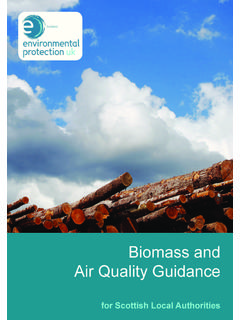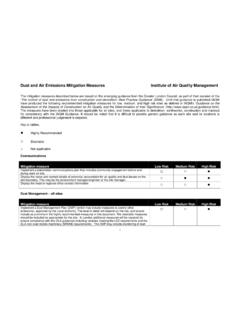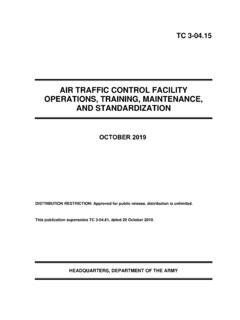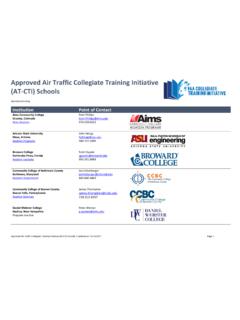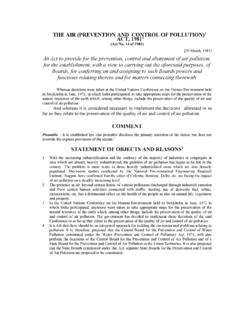Transcription of Land-Use Planning & Development Control: Planning For …
1 EPUK & IAQM u GUIDANCE. Planning For Air quality Land-Use Planning & Development control : Planning For Air quality Guidance from Environmental Protection UK and the Institute of Air quality Management for the consideration of air quality within the Land-Use Planning and Development control processes. January 2017. EPUK & IAQM u uGUIDANCE. GUIDANCE. Planning For Air quality Contents Acknowledgements 3. Record of substantive amendments 4. 1. Purpose and structure of this guidance 6. 2. The Role of the Planning Regime 8. 3. Links between poor air quality , human health and the environment 9. 4. Planning Framework 11. Policy context 11. Supplementary Planning Documents and Guidance 12.
2 The Planning Process 12. Material Considerations 12. Air quality as a material consideration 13. Linkages with other relevant issues 13. 5. Better by design 14. Introduction 14. Overarching Concepts in Land Use Planning for Better Air quality 14. Making Better Use of the Land-Use Planning System 14. Examples of Approaches to Reducing Emissions and Impacts 16. Principles of Good Practice 17. Offsetting Emissions 18. 6. Undertaking an Air quality Assessment 19. Purpose 19. The need for an air quality assessment 19. Impacts of the Local Area on the Development 20. Impacts of the Development on the Local Area 21. Content of an air quality assessment 22.
3 Agreement of datasets and methodologies 24. Describing the impacts 26. 7. Assessing Significance 29. 8. Mitigating Impacts 31. Abbreviations and acronyms 32. Table : Context of air quality and Planning in England. 12. Table : Stage 1 Criteria 20. Table : Indicative criteria for requiring an air quality assessment 21. Table : Impact descriptors for individual receptors 25. Figure 1: Procedure for Evaluating New Developments 7. Figure 2: Role of Local Authority and Applicant/Developer in the Planning process 15. 2. EPUK & IAQM u GUIDANCE. Planning For Air quality Acknowledgements Disclaimer: This guidance was produced as a result of the Environmental Protection UK: Environmental Protection UK.
4 Voluntary contribution of individuals within the Working is a national charity that provides expert policy analysis and Group, who are members of EPUK and/or IAQM, for which advice on air quality , land quality , waste and noise and their both organisations are grateful. Whilst this guidance represents effects on people and communities in terms of a wide range of a consensus view of the Working Group, it does not necessarily issues including public health, Planning , transport, energy and represent the view of individual members. climate. Membership of Environmental Protection UK is drawn from local authorities, industry, consultancies and individuals The information in this document is intended to provide who are practicing professionals in their field, or have an interest guidance for those working in Land-Use Planning and in the environment.
5 Development control , and does not constitute legal advice. The IAQM and EPUK have endeavoured to ensure that all The Institute of Air quality Management (IAQM): IAQM. information in this document is accurate. However, neither aims to be the authoritative voice for air quality by maintaining, organisation will accept liability for any loss, damage or enhancing and promoting the highest standards of working inconvenience arising as a consequence of any use of or the practices in the field and for the professional Development of inability to use any information in this guidance. We are not those who undertake this work. Membership of IAQM is mainly responsible for any claims brought by third parties arising from drawn from practising air quality professionals working within your use of this Guidance.
6 The fields of air quality science, air quality assessment and air quality management. Chairs of the Working Group Stephen Moorcroft, Air quality Consultants Graphic Design: Darren Walker ( ). Roger Barrowcliffe, Clear Air Thinking Copyright statement: Copyright of these materials is held by Members of the Working Group the members of the Working Group. We encourage the use of Paul Cartmell, Lancaster CC. the materials but request that acknowledgement of the source Mark Chapman, Jacobs is explicitly stated. All design rights are held by the IAQM, unless Ben Coakley, Chiltern DC. otherwise stated. Beth Conlan, Ricardo-AEA. Ana Grossinho, Air quality Experts Global Ltd Graham Harker, Peter Brett Associates Suggested citation: Moorcroft and Barrowcliffe.
7 Et al. (2017). Claire Holman, Brook Cottage Consultants Land-Use Planning & Development control : Planning for Air Nigel Jenkins, Sussex AQ Partnership quality . Institute of Air quality Management, London. Marilena Karyampa, Arup Julie Kent, Rotherham MBC Contact: I AQM. Rachel Kent, Wiltshire DC c/o Institution of Environmental Sciences Duncan Laxen, Air quality Consultants 3rd Floor, 140 London Wall, London Oliver Matthews, Carmarthenshire Council EC2Y 5DN. Fiona Prismall, RPS Planning & Development T: +44 (0)20 7601 1920. Rebecca Shorrock, Cheshire East Council E: Claire Spendley, South Oxfordshire DC. Stuart Stearn Date: January 2017.
8 Alex Stewart, Public Health England Adrian Young, Environment Agency Cover image: Stanko07 | EPUK & IAQM Land-Use Planning & Development control : Planning For Air quality 3. EPUK & IAQM u GUIDANCE. Planning For Air quality Record of substantive amendments June 2015. Original Revised Amendment made location location Table ; Table ; kWh' corrected to kW'. row 7 row 7. January 2017. Original Revised Amendment made location location Throughout --- Reference to LAQM TG (09) updated to reflect the Technical Guidance issued in 2016. Throughout --- Reference to the Environment Agency's H1 methodology updated to reflect the withdrawal of this guidance and its replacement in February 2016.
9 Replacement paragraph as follows: This guidance could be adapted for use in the Scottish and/or Northern Ireland Planning systems, because it is considered that the general principles of air quality assessment set out herein are applicable in all parts of the United Kingdom. Replacement final sentence: The Committee recommends that concentration response functions for the association between NO2 and premature mortality can be used, with some qualifications [footnote]. When applied on a national basis, use of these functions suggests that the national premature mortality burden for long term exposure to NO2 is equivalent to 23,000 deaths annually [footnote].
10 New footnote: average-concentrations-and-mortality New footnote: Additional paragraph: The guidance provided by the Environment Agency and Highways England has a formal status, reflecting the connections these organisations have with Government departments. This EPUK/IAQM guidance has no such status and is not intended as a substitute for the formal guidance. Additional text: The use of a Simple Assessment may be appropriate, where it will clearly suffice for the purposes of reaching a conclusion on the significance of effects on local air quality . The principle underlying this guidance is that any assessment should provide enough evidence that will lead to a sound conclusion on the presence, or otherwise, of a significant effect on local air quality .

